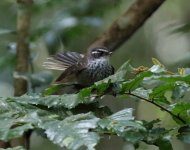
Ummmm..... it was in Australia. I'll go look up the subspecies there, 'cos I can't remember LOLUnless Delia tells us otherwise, I'm going to assume her Intermediate Egret was A. intermedia intermedia, meaning Plumed Egret and Yellow-billed Egret are both now available if anyone's seen one, thanks to the IOC's taxonomic generosity. Good luck finding a connection from either of them to Variegated Antpitta, though...








